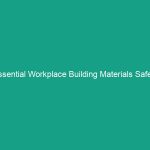Introduction
In today’s world, the importance of Health, Safety, and Environment (HSE) practices cannot be overstated, especially in industries that deal with hazardous materials. Among these, radioactive materials pose unique challenges and risks that necessitate stringent Safety Measures. The safe handling of radioactive materials is crucial not only for the protection of workers but also for the Safety of the public and the environment. This article aims to provide comprehensive guidelines and insights into the Best Practices for managing radioactive substances safely.
Regulatory Frameworks for Radioactive Materials
Understanding the regulatory frameworks governing the handling of radioactive materials is essential for compliance and Safety. Various national and international organizations set forth guidelines aimed at minimizing risks associated with radiation exposure.
International Regulations
The International Atomic Energy Agency (IAEA) plays a pivotal role in establishing international safety Standards. Their Basic Safety Standards (BSS) provide guidance on radiation protection, emphasizing the need for proper Training and safety protocols. These standards are designed to protect workers, patients, and the public from undue radiation exposure.
National Regulations
In the United States, the Nuclear Regulatory Commission (NRC) regulates the use of radioactive materials. Their regulations require licensing, safety assessments, and adherence to specific protocols for transportation, storage, and disposal of radioactive waste. Similarly, other countries have established their own regulatory bodies that enforce compliance with international standards while addressing local needs.
Compliance and Inspections
Regular inspections by regulatory bodies are crucial in maintaining compliance. Facilities that handle radioactive materials must undergo routine audits to ensure they adhere to safety protocols. Non-compliance can result in severe penalties, including fines and shutdowns, reinforcing the need for rigorous adherence to safety standards.
Best Practices for Safe Handling of Radioactive Materials
Implementing Best Practices is vital to ensure the safe handling of radioactive materials. These practices not only protect workers but also promote a culture of safety within organizations.
Training and Education
All personnel involved in the handling of radioactive materials must undergo comprehensive training. This training should cover the properties of radioactive materials, potential Hazards, and emergency response Procedures. Continuous education and refresher courses are also essential to keep staff updated on the latest safety protocols and technologies.
Personal Protective Equipment (PPE)
The use of appropriate Personal Protective Equipment (PPE) is a cornerstone of Workplace Safety. Depending on the level of exposure, workers should wear protective clothing, gloves, and respiratory protection. Regular assessments should be conducted to ensure that PPE remains in good condition and is suitable for the tasks at hand.
Radiation Monitoring and Detection
Regular monitoring of radiation levels within the workplace is critical. Facilities should be equipped with radiation detection devices, such as Geiger counters and dosimeters, to continuously track exposure levels. This data is crucial for ensuring that radiation exposure remains within allowable limits and for identifying areas that may require further Safety Measures.
Emergency Preparedness
Having a robust emergency response plan is essential for handling incidents involving radioactive materials. This plan should outline procedures for containment, evacuation, and decontamination. Regular drills should be conducted to ensure all personnel are familiar with their roles and responsibilities in the event of an emergency.
Case Studies in Safe Handling Practices
Examining real-world examples can provide valuable insights into the effective handling of radioactive materials. Case studies highlight both successes and lessons learned in the field.
The Chernobyl Disaster
The Chernobyl disaster of 1986 serves as a stark reminder of the catastrophic consequences of inadequate safety measures. Following this incident, significant changes were made to safety protocols and regulatory frameworks worldwide. The event highlighted the need for stringent safety regulations, proper training, and the importance of a safety culture within organizations.
Three Mile Island Incident
The Three Mile Island accident in 1979 was another pivotal moment in the history of nuclear safety. This incident prompted extensive reviews of safety procedures and emergency response plans across the industry. The lessons learned emphasized the importance of communication and transparency in preventing similar occurrences in the future.
Successful Implementation of Safety Protocols
On a more positive note, many facilities have successfully implemented comprehensive safety protocols that have significantly reduced incidents and exposure levels. For instance, a medical facility that handles radioactive isotopes for cancer treatment reported a 90% reduction in contamination incidents after implementing a rigorous training program and enhancing their PPE protocols.
Challenges in Safe Handling of Radioactive Materials
Despite the best efforts to ensure safety, several challenges persist in the handling of radioactive materials. Understanding these challenges is the first step towards addressing them effectively.
Public Perception and Fear
Public perception of radiation Hazards can lead to fear and resistance against facilities that handle radioactive materials. Education and transparency are essential in addressing these concerns. Engaging with the community and providing clear information about safety measures can help alleviate fears and build trust.
Resource Limitations
Many organizations face resource limitations that hinder their ability to implement comprehensive safety measures. Budget constraints can affect training programs, equipment purchases, and Maintenance. Organizations must prioritize safety spending to ensure compliance and protect workers effectively.
Technological Advancements
The rapid advancement of technology presents both opportunities and challenges. While new technologies can enhance safety and monitoring, they also require ongoing training and adaptation. It is crucial for organizations to stay informed about technological developments and integrate them into their safety practices.
Future Trends in Safe Handling of Radioactive Materials
The landscape of radioactive material handling is constantly evolving. Staying ahead of trends can help organizations adapt and maintain safety standards.
Enhanced Monitoring Technologies
Advancements in monitoring technologies are making it easier to detect and measure radiation levels accurately. Innovations such as real-time monitoring systems and automated alerts can significantly improve safety by providing instant feedback on radiation exposure levels.
Regulatory Changes and Updates
As scientific understanding of radiation and its Effects evolves, regulatory frameworks will continue to adapt. Organizations must remain vigilant and proactive in keeping abreast of changes in regulations and implementing necessary adjustments to their safety protocols.
Increased Focus on Sustainability
The growing emphasis on sustainability and environmental protection is influencing how organizations handle radioactive materials. Sustainable practices not only enhance safety but also contribute to a positive public image and compliance with environmental regulations.
Conclusion
In conclusion, the safe handling of radioactive materials is a multifaceted issue that requires a comprehensive approach to health, safety, and environmental standards. By adhering to established regulatory frameworks, implementing best practices, and learning from past experiences, organizations can significantly mitigate risks associated with radioactive materials. As we look to the future, ongoing education, technological advancements, and a focus on sustainability will play crucial roles in enhancing safety protocols. We encourage all organizations handling radioactive substances to prioritize safety, invest in training, and foster a culture of compliance and care for their workers and the environment.


